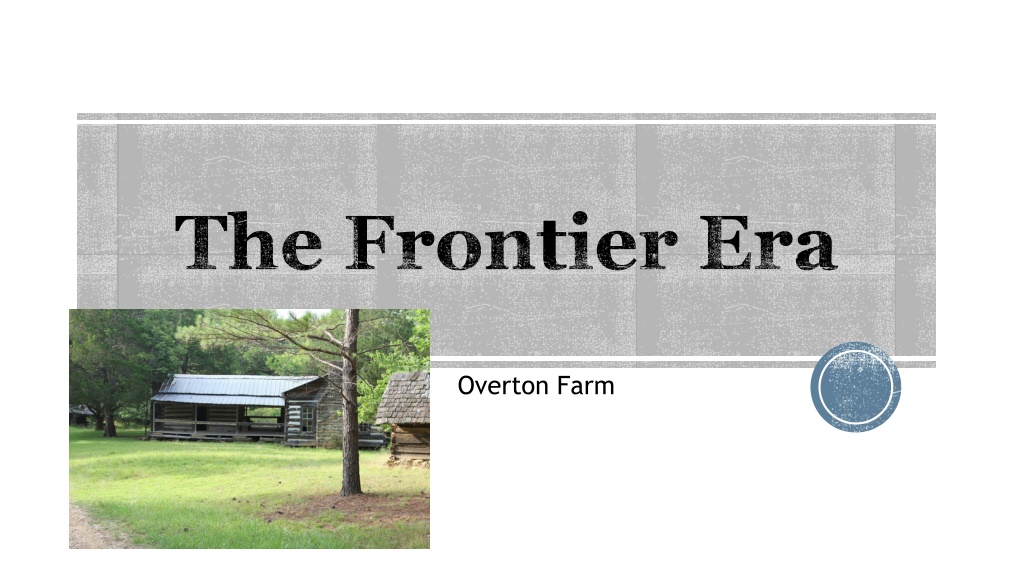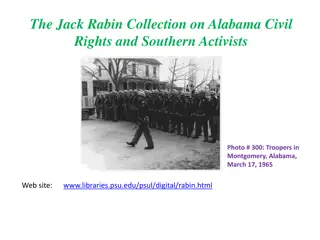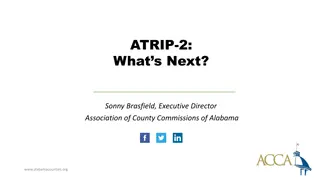The Frontier Era: Settlers and Growth in Alabama
Discover the historical journey through Alabama's frontier era, from the earliest inhabitants at Stanfield-Worley Shelter to European contact and settlement, the impact of Alabama Fever, settling the Bear Creek Watershed, the Overton family's arrival and home construction, and the significance of Dog-trot style houses in the region.
Download Presentation

Please find below an Image/Link to download the presentation.
The content on the website is provided AS IS for your information and personal use only. It may not be sold, licensed, or shared on other websites without obtaining consent from the author. Download presentation by click this link. If you encounter any issues during the download, it is possible that the publisher has removed the file from their server.
E N D
Presentation Transcript
The Frontier Era Overton Farm
The Earliest Inhabitants Stanfield-Worley Shelter inhabited by Paleoindians through Mississippian period Discovered in 1960 Paleoindian: ~15,000-9,000 years ago Mississippian Period: 1000-1550 CE Stanfield-Worley Bluff Shelter
European Contact and Settlement French trading post at Muscle Shoals before 1715 Cherokee villages in the latter eighteenth century The village of Oka Kapassa was established around 1770 Several clashes between the Native Americans and the earliest white settlers After Oka Kapassa battle white settlement increased
Alabama Fever 1812: government sells 144,873 acres in the Mississippi Territory 1813-14: Creek Wars cause a sharp decrease in land sales. In 1813, only 30,261 acres were sold March 27, 1814: End of Creek War, Alabama Fever begins 1810-1820: population of Alabama increased more than 1,000%
Settling the Bear Creek Watershed The watershed includes the majority of Franklin County, and also smaller portions of Marion, Colbert, Winston, and Lawrence Counties in Alabama, and Tishomingo County, Mississippi The watershed covers 801 square miles or 513,121 acres
Abner Overton comes to Alabama: An example of Alabama Fever During Alabama fever the Overton family first made their way into northwest Alabama 1815 - Abner Overton visits Alabama to sell tobacco 1817 - Abner Overton returns to buy land near Hodges and settle
Building a Home on the Frontier In 1838, the Overton family began to construct their second home Over the years rooms were added until it became a five room, dogtrot-style house Dogtrot homes were popular in the region because the breezeway between the sections allowed for airflow during the hot, humid summers
Dog-trot Houses The Overton home uses three types of notches Normally only one type of notch was used The notches used were the Ridge Lock, Saddle Notch, and Dovetail
Life on the Farm Corn was the staple crop Beans and peas were planted along with the corn so the vines could be supported by the corn stalks and make more use of the field area The Overtons also planted numerous fruit trees Making the most of field space was extremely important. Families had to produce almost all their daily food requirements
Animals on the Frontier The Overton family raised cattle, hogs, sheep, mules, and horses Furs from animals such as beaver, mink, and skunk who were trapped or hunted on the property were also sold or used for trading
Discussion Topics Who were the earliest inhabitants of Northwest Alabama? Name two of the later Native American tribes that lived in the area. What was Alabama Fever ? What first brought Abner Overton to Alabama and why did he decide to come back to stay? Why were dog-trot houses common in Alabama? How do the different types of notches work in constructing a home? What crops did frontier era families raise and why? What types of animals did they raise and what was each one used for?

















































